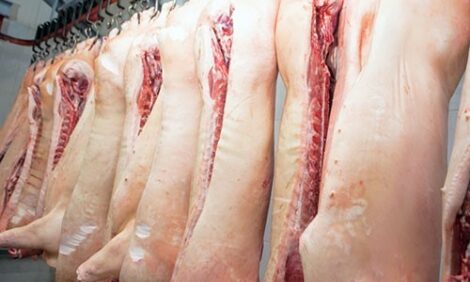



Majority of pigs are still tail docked in Europe, despite legislation
Pig tail docking – the cutting, clipping or cauterising of part of the tail in the first week after birth to prevent tail biting – is still routine practice in many European countries according to a study published in Porcine Health ManagementResearchers at the Federation of Veterinarians in Europe found that in 24 surveyed countries 77% of pigs are routinely tail docked, except in Finland, Norway, Sweden and Switzerland, where less than 5% of pigs are tail docked.
Reducing tail docking has the potential to improve animal welfare by avoiding pain and risk of consequent infections, according to the authors, who suggest that countries work together with veterinarians and farmers to implement action plans aimed at ending pig tail docking.
To prevent tail biting, which is associated with stress and frustration in pigs, surveyed veterinarians underlined the need to provide sufficient enrichment materials, water, food, and space for the animals to drink and feed, and to ensure that limits on how many animals are housed together are respected. According to survey respondents, only 67% of pigs across all 24 countries are provided with enrichment materials such as straw, toys or chains. In the four countries that stopped tail docking almost completely, enrichment materials are provided, animals are housed together in smaller numbers, and high standards are observed regarding temperature and air quality of the pigs’ living environment, their health status, competition for food and space, and diet.
The authors of this study suggest possible ways of facilitating the raising of pigs with entire tails. These include routine recording of tail biting, training from national authorities on how to avoid it, and increasing awareness of existing legislation. Amongst participants, 80% of respondents from countries without tail docking thought that such initiatives were effective or very effective compared to 3% from countries with routine tail docking. In countries that had stopped tail docking, 83% of people surveyed for this study reported the existence of training for veterinarians, compared to only 28% in countries with routine tail docking.
Legislation
European legislation dictates that pig tail docking is not allowed to be performed routinely (European Union. Council Directive 2008/120/EC of 18 December 2008 laying down minimum standards for the protection of pigs. OJ L 47, 18.2.2009). Nevertheless, tail docking is still practised routinely in many European countries, while four countries stopped routine tail docking completely. Tail docking is also practised in many countries outside Europe.
The study
The Federation of Veterinarians of Europe (FVE), the European Association of Porcine Health Management (EAPHM) together with the European Commission carried out an online survey to investigate the situation regarding the practice of pig tail docking and the provision of enrichment material across 24 European countries. It also focuses on the role of the veterinary profession and gives an overview on published literature regarding the challenges and possibilities related to the raising of pigs with intact tails.
Results
Fifty-seven (57) usable survey responses from 24 countries were received. On average 77% (median = 95%) of pigs are routinely tail-docked. In Finland, Norway, Sweden, Switzerland, less than 5% of the pigs are tail-docked. According to the respondents, 67% of pigs (median = 76%) across the 24 EU countries surveyed are given suitable enrichment materials. Training of veterinary practitioners, their role in advising the producer and undertaking a risk assessment of tail biting were more positively valued in countries that stopped routine tail docking than in countries that had not stopped routine tail docking. Initiatives such as training from national authorities to encourage abandoning tail docking and routine recording of tail biting at the slaughterhouse were identified as two successful items to promote the raising of pigs with entire tails.
Conclusions
In many European countries the majority of the pigs are still routinely tail-docked, which is a violation of the European legislation. To stop routine tail docking it is necessary to raise the awareness and education about risk factors to prevent tail biting. The growing knowledge about the reasons for failing voluntary national initiatives as well as about successful measures taken by some countries to make pig production with intact tails feasible should be distributed throughout the EU pig producing community. The veterinary profession has a significant role to play in raising awareness, facilitate knowledge transfer and to identify risk factors and solutions on farm level for the benefit of pig health and welfare.









